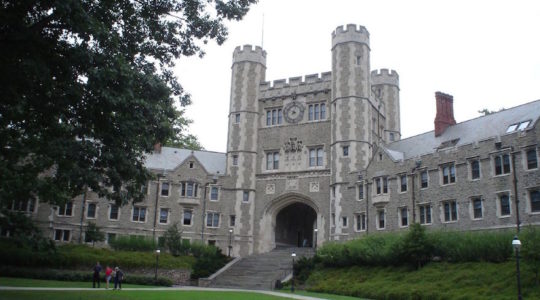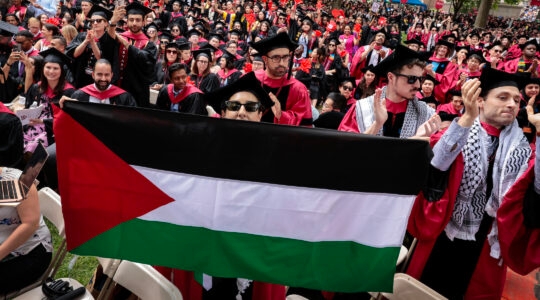BOULDER, Colo., Feb. 6 (JTA) — At a recent conference of Renewal rabbis, Rabbi Zalman Schachter-Shalomi steps forward to lead the Shema, the central declaration of Jewish faith.White beard flowing down upon his rainbow-colored prayer shawl, eyes shut tightly, Schachter-Shalomi breathes deeply between each word, exhaling the sounds slowly and distinctly.”She-ma.” Deep breath, pause. “Yis-ro-el.” Another breath, a longer pause. The roomful of rabbis and students falls into Schachter-Shalomi’s rhythm, letting his words linger on the air.The 82-year-old granddaddy of Jewish Renewal — the New Age, neo-Chasidic movement Schachter-Shalomi founded three decades ago — is an unlikely looking guru for a group known for its ecstatic prayer, drumming and dancing. He is a smallish man, not one to draw focus. He walks slowly, eyes peering out from round glasses, smiling quietly at people who grab his hand for a quick word. His charisma is muted, his power internalized.
But Reb Zalman, as he’s known to his followers, is the heart and spiritual engine of Jewish Renewal. He created the movement in the early 1970s, fusing the mystical traditions of his Lubavitch background with the sensibilities of the modern world in an effort to revitalize a synagogue practice he found stultifying. Pray from the heart, he exhorted people. Don’t be spiritually lazy.
He has led the movement since then, ordaining all its early rabbis and explaining its tenets to the outside world in numerous writings.
Nearing the end of his career and readying his archives for transfer to Naropa University, the Buddhist-inspired Colorado institution that was his last teaching post, Schachter-Shalomi remains the go-to guy for all things Renewal. That will have to change, which worries some.
“This man is a Chasid,” says Rebecca Alpert, chair of the religion department at Temple University, who has known Schachter-Shalomi since he sat on her doctoral committee 30 years ago. “No one could possibly duplicate his sagacity, presence and magic, and sometimes when his followers try to imitate him they must of necessity fall short.”
A paradoxical figure, one of the last of his generation, Schachter-Shalomi has spent his life trying to bridge the old and the new. For many within Jewish Renewal, he provides their only glimpse into the lost world of Eastern European Chasidism, a world he presents gently, non-coercively and filtered through his own highly personal lens of feminist-inspired egalitarianism, religious universalism and radical environmentalism.
“He’s opened up the Chasidic world as it really is, as real people,” says Rabbi Daniel Siegel, the first rabbi Schachter-Shalomi ordained in 1974. “That’s a huge gift.”
Outside Renewal, Schachter-Shalomi’s ideas have had a marked but largely unrecognized impact on mainstream Jewish practice.
“He has changed the Jewish map, changed the face of Jewish prayer,” Alpert says. “He has had a profound influence on bringing Jewish spirituality to a wide audience, and he doesn’t get the credit.”
Rabbi Arthur Green, president of Boston’s Hebrew College, also trumpets Schachter-Shalomi’s contributions. Reb Zalman was one of the first, he says, to lead prayers in English and put them to popular tunes.
He pioneered interest in Jewish mysticism, translating Chasidic texts into English and copying them on mimeograph machines to get them into people’s hands. He promoted eco-kashrut, popularizing the notion that protecting the environment is a Jewish commandment; introduced American Jews to the Lubavitch concept of spiritual mentoring and spiritual healing; and played with ritual, encouraging Jews to create their own colorful tallitot, or prayer shawls.
All of this has entered the American Jewish mainstream.
“He is not afraid to be irreverent while at the same time being very serious,” Green says.
Zalman Schachter — he added “Shalomi,” from the Hebrew word for peace, in later years — was born in Poland in 1924, raised in Austria and arrived in New York as a refugee in 1941. He attended a Lubavitch yeshiva in Brooklyn, was ordained there in 1947 and spent years setting up Lubavitch schools in New England and doing Chabad outreach work on college campuses with his better-known buddy and fellow emissary, Rabbi Shlomo Carlebach.
By the mid-1960s, both men had fallen out of favor with Chabad for adopting lifestyles far afield of the Lubavitch ideal. Schachter-Shalomi became a professor of religion at the University of Manitoba, earned his doctorate from Hebrew Union College and also taught at Brandeis, Temple and the Reconstructionist Rabbinical College, among other places.
He explored other religions, becoming a Sufi sheik and hobnobbing with Jesuit priests and the Dalai Lama, while still finding the time to establish the new field of “spiritual eldering” — an approach to the aging process that focuses on healing and spiritual growth — marry four times and take LSD with Timothy Leary, an experience he wrote and spoke about widely.
In 1969 Schachter-Shalomi founded the B’nai Or Religious Fellowship, which later morphed into Jewish Renewal.
Sitting in his hotel room at the Ohalah conference in early January — Ohalah is the Renewal rabbinic association — Schachter-Shalomi reflects on his life’s work. He says he is proud of Renewal’s encouragement of “feminine energy” and of “the artistic creativity” of Renewal practitioners, many of whom have become writers, musicians and artists exploring the boundaries of Jewish expression.
He’s proud of his efforts to introduce non-Orthodox Jews to the idea of spiritual direction, which is now offered at most rabbinic seminaries.
He’s also proud of his 10 children, 24 grandchildren and four great-grandchildren, even the four grown grandsons who are “Litvisher yeshiva people” — part of the non-Chasidic fervently Orthodox world — and won’t eat in his house, not trusting his kosher observance.
Schachter-Shalomi has been criticized for his close relations with other religious leaders, notably Catholic, Sufi and Buddhist. But that’s central to his spiritual construct: It’s time for Jews to get past their “triumphalist” thinking and realize that “we live in a post-denominational age,” he says.
The moment of clarity for Schachter-Shalomi was when he saw the first photograph of Earth taken from outer space.
“No boundaries, nothing, it’s alive,” he marveled. “We have to realize we are not at the top of the chain of life, but integral cells of that being, Earth. In that being, every religion is a vital organ. We need each other, we can learn from each other.”
Times have changed since Schachter-Shalomi began pushing the boundaries of Jewish practice four decades ago. His early followers came largely from Orthodox circles. They needed to be less resistant to outside influences, he says, whereas today’s Renewal practitioners often need the opposite.
At the Ohalah conference, Schachter-Shalomi cautioned his followers amid their singing, dancing and “getting into the emotional soup” that the words they are pronouncing so ecstatically “are meant to be prayers.”
“That’s Zalman in his old age,” says Green, a close friend. “He’s pulling back to his roots. He was very welcoming of New Age 25 years ago, and he’s now compensating for some of that enthusiasm. As he looks back, he says, ‘Some of the people went too far, they need to be more grounded.’ ”
Schachter-Shalomi says he has few real colleagues in the Jewish world, and no living teachers. Last summer he went to Ukraine to visit the graves of the great Chasidim: the Ba’al Shem Tov; his disciples Reb Pinchas of Koretz and the Maggid of Mezeritch; the Ba’al Shem Tov’s great-grandson, Rabbi Nahman of Breslov; and Reb Levi Yitzhak of Berdichev.
He accuses today’s Chabad leaders of being overly concerned with building infrastructure while neglecting the spiritual “inner work” their elders focused on, yet he speaks fondly of the past two Chabad rebbes, both of whom he knew and followed. He mourns the lost world they represented.
“I grieve for the fact that some of the greatest people we had, who were adept at their inner work, were killed” in the Holocaust, Schachter-Shalomi says. “The emotional stuff is what’s missing in Judaism today. It’s so dry.”
JTA has documented Jewish history in real-time for over a century. Keep our journalism strong by joining us in supporting independent, award-winning reporting.





